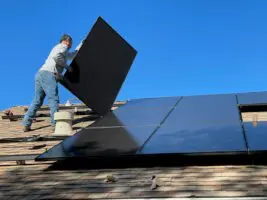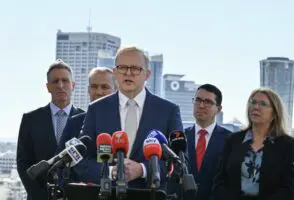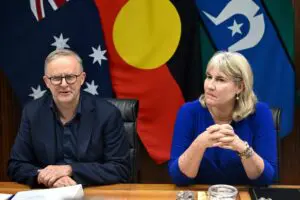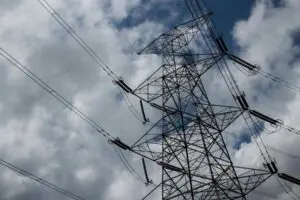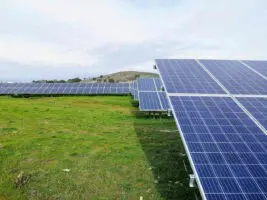One of the central parts of the Liberal and National Coalition’s pitch for re-election is that Federal Labor’s target to increase renewable energy to 50 per cent of power supplies by 2030 will significantly drive up electricity prices.
The core piece of evidence the Coalition has used to support this claim has been some economic modelling prepared by a firm called BAEconomics.
According to BAEconomic’s modelling Labor’s policies will lead to renewable energy rising to between 50% and 53% of Australia’s electricity supply by 2030. This will then lead to significant rises in wholesale electricity costs to somewhere between $110 to $135 per megawatt-hour.
My firm, Green Energy Markets, tracks almost every single major renewable energy project in Australia as it progresses through the stages of planning approval, to obtaining a power purchase agreement, commencing construction, and then ultimately generating power to the grid.
Given this information, I found this forecast by BAEconomics rather intriguing. This is because many renewable energy projects are being committed to construction on the back of contracts that sell their power far below $110 to $135 per megawatt-hour.
Below we’ve assembled and charted data on the actual contract power prices that have been revealed for a range of wind and solar projects.
The dark blue dots represent specific solar projects and the light blue wind projects. These are listed by the date at which the contract was agreed or announced.
Overlaid on top of this in the red rectangle is the price of electricity BAEconomics forecasts in 2030 as a result of Labor’s policy to increase renewable energy to 50% of our electricity supply.
Power contract prices announced for wind and solar projects in Australia since 2012

Back in 2012 and 2013 solar farm projects were quite expensive, as revealed by data from the ACT Government’s solar auction process.
However, in 2016 many in the energy industry were shocked when Origin Energy announced they had contracted the Clare Solar Farm for a price close to $85 per megawatt-hour.
Since then news has steadily leaked out of ever lower contract prices for solar farms, with the trend over time shown in the dark blue dotted line. Wind power contracts revealed since the ACT Government’s first wind auction were always well below BAEconomics cost estimate, and have also been trending downwards.
The most recently publicised contract prices were revealed by Snowy Hydro’s CEO Paul Broad at the Morrison Government’s press conference announcing Snowy 2.0 would proceed. At the press conference Broad told the assembled press, “we did a deal just before Christmas when we announced 888 megawatts of renewables and the average price for buying that was $40 [per megawatt-hour]”.
While the projects listed in the chart above are not comprehensive, these prices are corroborated by feedback we have gathered from a range of industry participants, as well as information disclosed by Origin Energy to investors.
Origin indicated that the going contract price for new wind and solar projects in financial year 2018 was half what BAEconomics estimates for 2030 – between $45 and $65 per megawatt-hour.
Origin Energy data on declining power purchase agreement contract prices for wind and solar projects from financial year 2012 to 2018

Some might suggest that one must add onto this the cost of energy storage because wind and solar projects cannot be relied upon.
A report involving the Australian Academy of Science and the Australian Academy of Technology and Engineering released by Chief Scientist Alan Finkel estimated we’d need 5 gigawatt-hours of energy storage to ensure reliability in a system with 52% renewables. So how much extra cost will this impose on us if Labor are elected?
The answer is zero.
The Coalition Government has already committed taxpayers to funding the Snowy 2.0 pumped hydro project and has also been telling voters it will underwrite construction of Hydro Tasmania’s Battery of the Nation Stage 1 projects.
Just these two projects will provide 387 gigawatt-hours of energy storage, or 77 times what’s needed to accommodate 50% renewables.
Energy storage required for 50% renewables vs amount from projects already announced by Morrison Government

What is disappointing is that while Coalition ministers have been keen to promote the results from BAEconomics’ theoretical modelling exercise, they should be well aware of what is occurring in the real world.
That’s because this real-world information would have formed the underpinning basis for spending several billion dollars of taxpayers’ money buying and then expanding Snowy Hydro.
Snowy Hydro CEO Paul Broad laid out the numbers to the media in front of Energy Minister Angus Taylor, Finance Minister Mathias Cormann and Prime Minister Morrison. Not only did he say he’d been able to contract power from wind and solar projects at $40 per megawatt-hour, he also said,
“…just to cover the black coal price in New South Wales, to generate… just the coal price is $56 [per megawatt-hour]….. 74 per cent of the market is still supplied by coal. As renewable [energy] is coming in, the prices are coming down. As we said the other day when we did the deal on renewables and firmed it up, so that’s equivalent to baseload, we [are] firming that in sub-seventy [dollars per megawatt-hour]. We think that price is going to look like sub-sixties.”
So the government is allocating several billion dollars to a man ready to write contracts with customers to provide them with reliable, renewable energy for less than $70 per megawatt-hour. Meanwhile, they also want us to believe an economic modeller’s prediction it will cost us almost twice that amount.
But the thing is you can’t believe both are true.
Tristan Edis is director of analysis and advisory at Green Energy Markets


